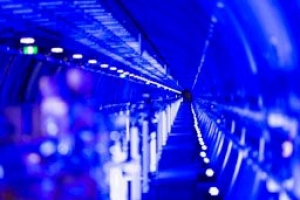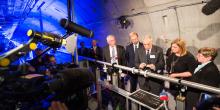European XFEL (X-ray Free Electron Laser) commissioning procedures started in DESY research centre in Hamburg on October 6, 2016. Poland has met its obligations as the first among 8 shareholders of the European XFEL GmbH company established to accomplish that €1.2 billion-worth project. On that occasion a small celebration was held in Hamburg with participation of Dr. Piotr Dardziński, Polish Deputy Minister of Science and Higher Education.
The entire equipment of the facility has already been successfully installed. Electrons accelerated in the first part of the facility will generate beams of coherent radiation in the optical part. Both parts have been installed in a 5.8 km long underground tunnel. The beams will be routed to several bays in a research hall at the tunnel end, where scientific experiments are to be conducted. Commissioning of such a large facility is a pretty time-consuming process; the first beam is planned within less than a year from now.
European XFEL will generate extremely short but extremely bright pulses of laser radiation, repeated 27 thousand times per second. Within each pulse intensity of radiation will be billions of times higher than intensity of radiation emitted by the best conventional X-ray sources. Advantages in comparison to conventional lasers include: (i) unprecedented source brightness; (ii) very short duration of each pulse; (ii) capability to tune radiation wavelength from millimetres (THz microwave radiation) down do nanometres (billionths parts of one metre, X-rays). The advantages are particularly useful in studies on low-probability phenomena, experiments with very diluted biological samples, or technological applications (e.g. modification of surfaces of various materials). Such pulses will be able to image structure of viruses (which should help to develop new medicines), cell molecular mechanisms, and other objects of the nano-world. European XFEL will be capable to film course of chemical reactions (e.g. to show how chemical bonds are formed/broken) and to study processes running inside stars/planets.
Poland’s contribution to the European XFEL project was delivered by three teams operating in Cracow, Wrocław and Warsaw. All the works were coordinated by NCBJ.
„I would like to acknowledge tremendous efforts put by all the teams into development and commissioning of European XFEL, a very advanced HiTech research infrastructure” – said Minister Piotr Dardziński – „Unique competences acquired in the process will surely help to increase their competitive edge on the Polish market. This is an excellent example of our country’s economic development via participation in projects belonging to the greatest scientific challenges of the 21st century”.
The first elements delivered back in 2012 developed by Wrocław University of Technology, Wrocław Technology Park, and the Kriosystem S.A. Wrocław-based company included a cryogenic line for transporting liquid helium in the supercritical state and two cryostats for testing niobium superconducting resonators (some key components of XFEL electron accelerator). Value of the deliveries amounted to about € 2.1 million (2005 prices). Institute of Nuclear Physics PAN in Cracow (IFJ) has performed tests of 816 superconducting 1.3 GHz resonators plus 100 cryo-modules (value of the works: € 11.7 million), and tests of 100 superconducting beam focussing/control magnets with current conductor subassemblies (€ 1.1 million). NCBJ (formerly IPJ Świerk) designed, constructed, tested and delivered to DESY 1,648 superconducting couplers of the higher (parasitic) modes in the XFEL electron accelerator, 824 HF diagnostic antennas with external lines, and 108 absorbers for propagating higher modes. Total value of the deliveries amounted to about € 3.5 million. According to the just signed agreement NCBJ is to deliver 200 electronic modules to be used to control optical lines and equipment installed in research bays; the modules will be housed in 100 cassettes. Total values of these deliveries (to be completed before spring 2017) amounts to € 741 thousand. Combined value of the Polish contribution amounts to € 26,535,060 including € 19,131,857 (2005 prices) “in-kind” and € 7,404,203 financial contribution.
Our scientists will soon participate in international teams conducting research on European XFEL. As project shareholder, Poland will co-own all the developed solutions and all the inventions discovered during that research.
„Poland signed an agreement with European XFEL GmbH on framework of future scientific cooperation at the European XFEL facility in July this year.” – said Prof. Krzysztof Kurek, NCBJ Director General – „Polish engineers have already accomplished their tasks, now it is time for Polish scientists. As evidenced by success of the meeting organized in April in Świerk, interest in XFEL-created research opportunities among Polish scientists is huge. We hope that they will co-author some important scientific breakthroughs soon”.
More on the European XFEL project: www.xfel.eu








